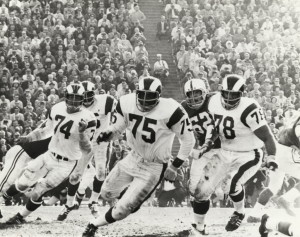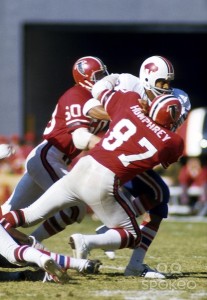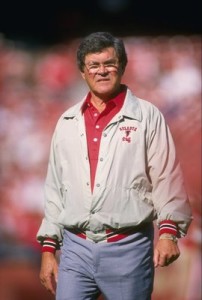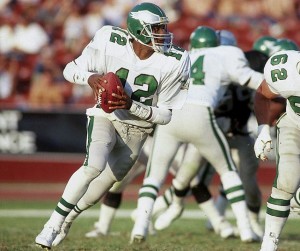Today you’re in for a treat, as frequent commenter Shattenjager has contributed an absolutely outstanding guest post.
Introduction: Question
Every time I have looked at Marion Campbell’s coaching career, a question has leapt to mind: How on earth did he keep getting jobs?
When Chase Stuart recently revisited Doug Drinen’s Dungy Index to measure coaches’ performances in the regular season compared to expectation, the man who appeared dead last in Wins over Expectation was former Falcons and Eagles head coach Marion Campbell, at a rather staggering -14.9. His teams essentially lost 15 more games than a linear regression based on Pythagorean winning percentage expected.
“So what?” you might think, “He was just a terrible coach.” I wouldn’t blame you for having that reaction. However, here’s what’s really fascinating about Marion Campbell: he had three separate head coaching stints.
Strictly looking at win-loss records is a poor measure of a coach, but it works well enough as a shorthand overview of Campbell’s career. He went 6-19 as the Atlanta Falcons head coach 1974-1976 after Norm Van Brocklin was fired during the 1974 season. Then, several years later, he took the head coaching job of the Philadelphia Eagles after Dick Vermeil famously stepped down due to burnout and promptly went 17-29-1 over the next three seasons before being fired again with one game remaining in the season. Just a year later, the Falcons—yes, the same Falcons who had already hired and fired Campbell as their head coach—decided that Campbell was the man to replace newly-fired Dan Henning. He rewarded them with an 11-32 run that ended with his retirement late in the 1989 season.
Again, how did he keep getting jobs? Well, it’s complicated, but I think an in-depth look at his career can explain it.
Act I: The Swamp Song
Campbell, like most head coaches, began as a player. (Well, he began as an egg that was fertilized into a zygote, but he came to football as a player.) Like many, but not as many, head coaches, he was a good enough player to make it to the NFL. Like relatively few head coaches, he was a successful NFL player, accumulating 34 total AV as a defensive lineman, with two Pro Bowl appearances, a Sporting News All-NFL team appearance, and a fairly cool nickname (“Swamp Fox”).When his playing career ended, Campbell turned to coaching, becoming the Boston Patriots defensive line coach for two years under Lou Saban and Mike Holovak. [1]This article describes Campbell’s position as defensive line coach with the Patriots and says that he is leaving for a “similar position” with the Vikings. He then moved on to the Minnesota Vikings in the same position under Van Brocklin, spending three years training up a young defensive end combo of Carl Eller and Jim Marshall. When Van Brocklin was fired, Campbell took the same job under George Allen with the Los Angeles Rams, [2]This article on Campbell’s move to Atlanta describes his position with the Rams. coaching the dominant Merlin Olsen–Deacon Jones pairing for the next two seasons. It’s difficult to tease out his contributions as a defensive line coach, but he was on the staff for some excellent defenses (especially in L.A.) and was the position coach for some young players who became stars as well.
Meanwhile, his former boss Van Brocklin took over the Atlanta Falcons as head coach and general manager during the 1968 season. It was no surprise and doesn’t look at all unusual that he hired Campbell as his defensive coordinator before the 1969 season.
Act II: It Comes and It Goes
Campbell coached Van Brocklin’s defense for more than five years, and while the team was not successful, the defense definitely wasn’t to blame.
The Falcons entered the NFL in 1966, and the 1968 team still felt like an expansion team. Atlanta was terrible in all facets that season, with its only Pro Bowler being still-young linebacker Tommy Nobis. In 1969, Nobis missed 11 games, and yet the defense improved significantly under Campbell’s direction, ranking in the top half of the league in NY/A and points allowed. The team also changed personnel significantly, returning only four starters (though Nobis was of course intended to start as well) and starting an 11-man unit that averaged 23.9 years old for the season, making it difficult to figure out how much of the improvement should be attributed to Campbell. Still, the improvement was there.
Throughout the rest of Campbell’s tenure as the Falcons defensive coordinator under Van Brocklin, the defense, particularly the pass defense, was the team’s strength. From 1969-1973, the Falcons ranked in the top half of the league in scoring defense four times and ranked 14th of 26 teams the other year. Atlanta’s ranks in NY/A allowed were 6 (of 16 teams), 17 (of 26), 2, 8, and 2. It’s not the Steel Curtain, but that’s still an impressive run of success for Campbell’s unit.
And the defense had that success with little individual recognition. The highly-decorated Nobis missed most of the season again in 1971 and seems to have hit an age wall as he approached 30, making his last All-Pro team in 1968 and his last Pro Bowl in 1972. The only other highly-decorated player was three-time Hall of Fame finalist Claude Humphrey, who made five straight Pro Bowls and was selected to some sort of All-Pro team every season under the Van Brocklin/Campbell pairing. No one else who played defense for the Falcons in this period received post-season recognition of any kind in more than one season.In 1974, everything cratered for the Falcons. The team still ranked a respectable 16th in points allowed and fifth in NY/A, but the rush defense ranked only 18th in YPC allowed while the passing offense was as bad as any that has ever existed. [3]The team averaged 3.2 NY/A in a league where the average was 5.3 NY/A. That was more than two standard deviations below the league average. It was a very, very bad passing team. Owner Rankin Smith fired Van Brocklin with six games remaining in the season, issuing an odd statement rebutting the public perception that he was too afraid of Van Brocklin to fire him: “Norman Van Brocklin has been relieved of his duties as general manager and coach of the Atlanta Falcons. Marion Campbell has been appointed head coach. I have not been hiding in Miami.” [4]See this Sports Illustrated article, which explains that Smith had been faulted for not already firing Van Brocklin, with some claiming that it was because “Smith had no stomach for a confrontation … Continue reading
I find it difficult not to come away impressed with Campbell’s run as Van Brocklin’s defensive coordinator. The defense was consistently successful without getting any help from a good offense putting them in good positions, a strong defensive mind as a head coach, or players who received much recognition. While the team’s position as a losing team in a less-than-gigantic market could explain away at least some of the lack of recognition, it still looks like Campbell was a good defensive coordinator, particularly against the pass.
As a result, it’s not surprising that the Falcons decided to hire Campbell to take over. The change from the fire-breathing Van Brocklin to the easy-going Campbell [5]See this article. fits well into Doug Drinen’s belief that radical changes in coach personality can be good for a team, [6]See this post and somewhere on one of these podcasts where he expands on the issue a bit. (I remember him doing it, but cannot remember enough context to remember the episode. They’re all worth … Continue reading and there’s certainly logic to hiring the guy who’s been coaching the one successful part of the team as the new head coach.
Act III: Bottom Feeder
Campbell’s tenure as the Atlanta head coach did not begin auspiciously. First, the team responded to the coaching change by going 1-5 down the stretch in 1974, though I’m never a fan of blaming an interim coach for his record. Then, All-Pro DE Claude Humphrey injured his knee and ultimately missed the entire ’75 season.
Other than the coaching change, the team’s biggest change was to hire Pat Peppler, who had been the Packers Director of Player Personnel from 1963-1972 and then moved on to the Miami Dolphins. Peppler’s record was already mixed, having been in charge for a lot of wins, but also having only taken over already championship-level teams. His first major move was to trade five-time Pro Bowl OT George Kunz for the top pick in the draft and take QB Steve Bartkowski. [7]Reports differ about whether Peppler or Campbell actually made this move, but it seems nearly impossible to me to believe that Smith hired Peppler and not only did not give him authority to hire and … Continue reading In his first season, Bartkowski proved himself a drastic improvement on what the team previously had at QB, producing a 98 ANY/A+ in 11 starts that essentially equates to league average. While he was out, Pat Sullivan and Kim McQuilken raised their ugly heads, with the latter producing an incredible -2.58 AN/YA (35 ANY/A+) in his two starts.In Campbell’s one full season as the head coach, the team was 4-10 and his trademark defense slipped. The team ranked right around the middle of the league in almost every defensive category except for facing a very large number of plays thanks to the offense’s inability to extend drives and penchant for turning the ball over.
It’s difficult to assign blame for the 1975 season. Losing Humphrey was obviously a major blow to the defense and longtime stalwart Nobis was nearing the end of the line at MLB, but even a rookie Bartkowski was also a noticeable upgrade over the McQuilken/Bob Lee/Sullivan trio that had started in 1974. All told, it seems that Campbell didn’t do anything special one way or the other in his first full season as a head coach.
However, Peppler recommended firing Campbell after the season, which rankled Smith. [8]See this Sports Illustrated article. The situation was the subject of much derision and comic relief for sports writers, inspiring one SI writer to pen a rather bizarre “morality play” … Continue reading When the team began the 1976 season 1-4, culminating in a 30-0 loss to the lowly New Orleans Saints during which the badly-regressing Bartkowski suffered a season-ending injury, Smith fired Campbell and handed his GM the head coaching job, over Peppler’s own objections. For what it’s worth, the team went 3-6 under Peppler, who finally put Kim McQuilken out of his misery a few games into his tenure and handed the job to the terrible-but-not-Kim-McQuilken-terrible Scott Hunter.
It certainly wasn’t a successful run for Campbell, but one can see the extenuating circumstances that could lead him to be forgiven for his term as head coach. He took over a terrible team and it stayed terrible even when he was given a shiny new QB, but he was also forced to give Kim McQuilken four starts because of injuries, and Peppler gave him little besides Bartkowski with which to improve the team’s fortunes.
After losing that job, Campbell returned to the position at which he had earlier excelled, defensive coordinator, with the Philadelphia Eagles under Dick Vermeil.
Act IV: Philadelphia Freedom
For the next six years, Campbell served as the defensive coordinator of Vermeil’s squad, including for the team’s 1980 Super Bowl appearance. For the first five years of that run, the team was very good on defense, with positive defensive SRS scores every season, and was quite dominant on pass defense, ranking in the top five in NY/A three times and leading the league in that category in 1981. It cratered in the strike-shortened 1982 season, after which Dick Vermeil retired due to burnout, but between the strike and Vermeil’s situation, it’s awfully difficult to explain what happened to the team.
That defense included a number of players who received some recognition, but the only to do so more than once were 2-time first team All-Pro Charlie Johnson and two time Pro Bowler Bill Bergey and the only one to get any recognition before Campbell’s arrival was Bergey.
At this point, we can see a real trend in Campbell’s defenses when he is the coordinator, and it’s a good trend. Not only were most of his defenses in both stops above average, but they were particularly good at pass defense, and in each case it was while only one player — a lineman — received great acclaim (Humphrey in Atlanta and Johnson in Philadelphia).
The Eagles thus turned to Campbell to replace Vermeil, and it’s a decision that makes at least some sense. Yes, he had failed as a head coach in Atlanta, but there were extenuating circumstances and he had years of success in Philadelphia now behind him.
It didn’t work out.
In 1983, the team went 5-11 thanks to an average defense and a well below-average offense that ranked with the worst in the league on the ground. The next season, the defense improved (particularly against the pass), but the running game didn’t and 33-year-old Ron Jaworski missed three games, and so the team still finished 6-9-1. Entering a do-or-die season in 1985, he was handed a new quarterback, but it was a raw rookie named Randall Cunningham whose electric athleticism was combined with some positively awful passing. [9]Ryan Lindley last year had a 48 ANY/A+. Campbell’s old friend Kim McQuilken had a 49 in ’76. Cunningham in ’85 had a 43. Campbell inserted the rookie in Jaworski’s place anyway after an ugly loss in the season opener, only to see the team go 1-3 under Cunningham and re-insert Jaworski. The team still showed improvement in essentially all areas, but finished 7-9, with Campbell being fired before the final game of the season (a win that the players dedicated [10]See this report. to Campbell).This time, there isn’t much of an excuse to be made for Campbell. He took over a team that had played very poorly the year before, but he still had some good players, including a solid if unspectacular veteran quarterback and a very good young wide receiver (Mike Quick). For his last season, he even had a small additional weapon on his defense in the person of former USFL defensive lineman Reggie White. Jaworski was aging and missed a few games, but his numbers didn’t show a major drop until after Campbell left town and the team’s record in his starts was still only 16-24-1. At this point, it looks like Campbell has really proven himself to be a good defensive coordinator who just isn’t a good head coach.
Act V: He’s Back (The Man behind the Mask)
In a last-ditch effort to save his job, Dan Henning immediately hired Campbell as defensive coordinator for his failing Falcons, pleasing the owner who hadn’t wanted to fire Campbell a decade earlier. [11]While the sports media provides some more colorful versions, the fact that Smith gave Henning the extension on the condition that he hire Campbell is reported here. The Falcons had been a woeful team for the past two years, with the lone bright spot being productive running back Gerald Riggs. Campbell’s hiring seemed to pay immediate dividends, with the Falcons opening the ’86 season 5-1 and playing well on both sides of the ball, but Atlanta still finished 7-8-1. The defense had improved but was still far from good, and it turned out that a career year from quarterback David Archer was just not that impressive. Henning was fired after the season.
Marion Campbell ended up with the job, and this is the hiring that makes Campbell bizarre—a two-time failure hired again. And he wasn’t just hired again, but hired again by the team that hired him the first time. It’s difficult to say he hadn’t proven that he wasn’t much of a head coach at this point, so what happened?
Well, apparently Rankin Smith happened. Accounts of the hiring process the Falcons went through are very reminiscent of what happened with the Raiders in 2006. Sports Illustrated’s Rick Telander [12]See Tellander’s article on the lack of black head coaching candidates. wrote, “For six weeks the Falcons offered the job to virtually any current or former head coach from any league who had a remote interest in settling in Suwanee, Ga.” Smith apparently offered the job to a smorgasbord of coaches including Dick Vermeil, Dan Reeves, and even Bill Parcells [13]See this report. but they all turned him down. In a contest with no real winners, David Shula campaigned for the job, [14]Reported here. Perhaps surprisingly, this was not the first time Shula and Campbell had been linked. but Smith instead turned to the old Swamp Fox.
In the next three years, Campbell’s team went 11-32 and didn’t have any noteworthy success anywhere. He retired with four games remaining in the 1989 season, saying that he wanted to give the team a chance to move on. [15]Reported here. He never returned to the NFL.
Conclusion: How You Gonna See Me Now?
So, how did Marion Campbell keep getting jobs? First, he was a good defensive coordinator who was well-liked by players and management alike. Second, circumstances made it easy to explain his failure at his first head coaching stop. Third, his final hiring seems to have been by default as a meddlesome owner had scared away most legitimate coaches.
This is the stuff that the worst head coaching career in history is made of.
References
| ↑1 | This article describes Campbell’s position as defensive line coach with the Patriots and says that he is leaving for a “similar position” with the Vikings. |
|---|---|
| ↑2 | This article on Campbell’s move to Atlanta describes his position with the Rams. |
| ↑3 | The team averaged 3.2 NY/A in a league where the average was 5.3 NY/A. That was more than two standard deviations below the league average. It was a very, very bad passing team. |
| ↑4 | See this Sports Illustrated article, which explains that Smith had been faulted for not already firing Van Brocklin, with some claiming that it was because “Smith had no stomach for a confrontation with the spirited Van Brocklin.” |
| ↑5 | See this article. |
| ↑6 | See this post and somewhere on one of these podcasts where he expands on the issue a bit. (I remember him doing it, but cannot remember enough context to remember the episode. They’re all worth listening to anyway.) |
| ↑7 | Reports differ about whether Peppler or Campbell actually made this move, but it seems nearly impossible to me to believe that Smith hired Peppler and not only did not give him authority to hire and fire coaches but allowed the head coach to make the most important personnel move of the offseason without him. Having read a lot about Smith’s ownership during this writing, I know that he was incredibly incompetent, but I still find it easier to believe that Peppler made the move and it was credited to Campbell the way personnel moves are often credited to head coaches whether they make them or not. |
| ↑8 | See this Sports Illustrated article. The situation was the subject of much derision and comic relief for sports writers, inspiring one SI writer to pen a rather bizarre “morality play” about the incident. |
| ↑9 | Ryan Lindley last year had a 48 ANY/A+. Campbell’s old friend Kim McQuilken had a 49 in ’76. Cunningham in ’85 had a 43. |
| ↑10 | See this report. |
| ↑11 | While the sports media provides some more colorful versions, the fact that Smith gave Henning the extension on the condition that he hire Campbell is reported here. |
| ↑12 | See Tellander’s article on the lack of black head coaching candidates. |
| ↑13 | See this report. |
| ↑14 | Reported here. Perhaps surprisingly, this was not the first time Shula and Campbell had been linked. |
| ↑15 | Reported here. |




